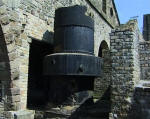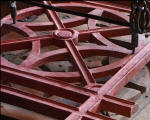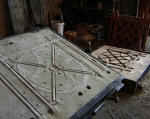Iron and Steel
2 Cast Iron - Manufacture
| In the 1700s the production of iron was mostly restricted to the small-scale smelting of iron ores. Iron was produced by smelting it with charcoal but this was in short supply (it was made by partially burning wood to give a carbon-rich material). Coal, a much more plentiful material than carbon, unfortunately produced iron of poor quality due to the high concentration of sulfur. We can thank the Darby family for the development of cast iron as an engineering material because they realised that coal could be used to produce coke (made by heating coal much in the same way that charcoal is made from wood) and that coke was the key to successful iron production. | ||
|
|
Iron is extracted from naturally occurring ore - most commonly iron oxide (FeO). In the early days of the Industrial Revolution the production of iron required three stages:
The pictures (left, right and below) show Florence mine on the western fringes of the Lake District. Metal mining in the west of Cumbria was dominated by the large deposits of high grade hematite iron ore found in the limestone strata. |
|
|
|
During the Industrial Revolution most ores were found in the coal
bearing strata where they naturally occurred along side coal (the fuel)
and limestone (the flux). The main British iron ores were:
|
|
 |
The typical chemical reaction of an iron oxide is FeO + C > Fe + CO: Iron Oxide + Carbon heated along with a blast of air > Iron + Carbon Monoxide (a gas released into the air). This process does not yield pure iron, but an impure product called pig iron - so called because the molten metal from the blast furnace was run into long channels with branches formed in sand, called the 'sow and her pigs'. This pig iron was produced in a variety of grades depending on the heat of the furnace and the nature of the original ore. Despite the flux, many pig irons still contained a number impurities including carbon, silicon, sulfur, phosphorous and manganese. |
|
 |
Cast iron is the material produced by re-melting this
pig iron in a cupola (a small furnace). A small amount of limestone flux
was added - the quality and use of the finished cast iron depended on
the quality of the pig iron. Some of the poorer qualities were only
suitable for crude castings such as sash weights while the better ones
were suitable for the manufacture of engines, columns and girders etc.
In the early days of cast iron production, it was difficult to control the level of carbon and other impurities such as sulfur. This meant that the strength and properties of the material were very much a hit-and-miss affair. Consequently, early cast iron structural elements were often load tested before being used in a building. It was also brittle because of the amount of carbon it contained (about 4%). |
 |
 |
Castings were formed by pouring the molten iron into metal frames or
boxes (a top box and a bottom box) containing sand; an impression of the
casting having been formed in the sand using a wooden pattern. The sand
set quite firm and allowed substantial detail in the mouldings. The
wooden pattern was cut a fraction too large to allow for iron's
shrinkage as it cooled (about 1%). Nowadays these traditional techniques
are still used although a special sand is used which hardens quickly
when injected with carbon dioxide. Click here to see a short video clip of a 'traditional' casting. |
 |
Failure of castings (a not uncommon event) could be caused by:
In fact failure was so common that engineers and designers often included specification clauses in contracts which required extensive testing. The example below was written by the architect Theodore Sington in the 1890s. "All the castings are to be made of re-melted iron of a quality and mixture to be approved by the architect; they are to be finished... with clean even surfaces, free from sand, air holes, and all other imperfections or flaws. ...All the castings must be left in the sand moulds for at least ten hours before being taken up. The contractor must state in his tender the description and proportions of the different kinds of iron he proposes to use in the castings, which in respect of strength must stand the following test: Two bars are to be cast each day on which any of the castings are being run, 3ft. 6in. long, 1in. broad and 2in. deep. Upon due notice being given, the architect will test one of these by placing it edgeways on bearings 3ft. apart and loading the middle of the bar. Should it break with any weight less than 25cwt., all work cast with that metal will be rejected. The other bar is to be marked with the date of the casting and delivered to the architect at the works." |
||
except where acknowledged